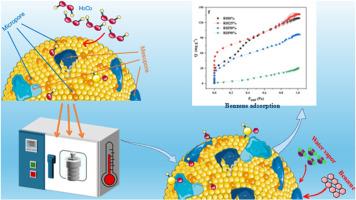The viability of mildly oxidized microporous carbons for adsorptive removal of gaseous aromatic hydrocarbons in humid air
IF 8.4
2区 环境科学与生态学
Q1 ENVIRONMENTAL SCIENCES
引用次数: 0
Abstract
The adsorption efficacy of commercial activated carbon (AC) toward volatile organic compounds (VOCs) is generally impeded by the presence of moisture under real environmental conditions. To address this limitation, surface modification strategies such as oxidative treatments are employed to enhance the hydrophilicity of AC. In this study, coconut shell–based AC (CSAC) is subjected to mild hydrogen peroxide (H2O2) oxidation at 100 and 125 °C, producing samples labeled as CSAC100 and CSAC125, respectively. The oxidized CSAC samples are tested against gaseous benzene (10 ppm) in dry and humid conditions using raw CSAC as reference. Under dry conditions, CSAC100 and CSAC125 exhibit enhanced adsorption capacities (Q100%) of 124.1 and 128.7 mg g−1, respectively relative to CSAC (108.1 mg g−1). At 25% RH, they record the optimal uptake performance in terms of Q100% (135.4/136.9 mg g−1) and partition coefficients (PC100%: 1.73/1.75 mol kg−1 Pa−1). The intraparticle diffusion model confirms that the diffusions of benzene across the oxidized CSACs proceed more favorably at 25% RH than in dry air, supporting their active adsorption of water vapor. Furthermore, the enhanced benzene uptake (e.g., Q100% (mg g−1)) of the oxidized AC samples is evident such as CSAC100 (78.3) and CSAC125 (96.6) relative to untreated CSAC (60.8) at 50% RH. The high adsorption performance of the oxidized CSACs, regardless of the moisture level, can be explained by the presence of additional mesopores with strong hydrophilicity. Overall, this study should provide the practical guidelines to tailor the sorbent properties required for the upscaled production of advanced adsorption systems to operate efficiently in the presence of moisture.

轻度氧化微孔碳吸附去除潮湿空气中气态芳烃的可行性
在实际环境条件下,商品活性炭(AC)对挥发性有机化合物(VOCs)的吸附效果通常受到水分的影响。为了解决这一限制,采用氧化处理等表面改性策略来增强AC的亲水性。在本研究中,基于椰子壳的AC (CSAC)在100°C和125°C下进行轻度过氧化氢(H2O2)氧化,得到的样品分别标记为CSAC100和CSAC125。氧化后的CSAC样品以原料CSAC为参考,在干燥和潮湿条件下对气态苯(10ppm)进行测试。在干燥条件下,CSAC100和CSAC125的吸附量(Q100%)分别比CSAC (108.1 mg g−1)提高了124.1和128.7 mg g−1。在25%的相对湿度下,它们在Q100% (135.4/136.9 mg g−1)和分配系数(PC100%: 1.73/1.75 mol kg−1 Pa−1)方面记录了最佳的吸收性能。颗粒内扩散模型证实,在相对湿度为25%时,苯在氧化csac上的扩散比在干燥空气中更有利,这支持了它们对水蒸气的积极吸附。此外,与未处理的CSAC(60.8)相比,在50% RH下,氧化AC样品的苯吸收率(例如,Q100% (mg g−1))明显增强,例如CSAC100(78.3)和CSAC125(96.6)。氧化CSACs的高吸附性能,无论水分水平,可以解释为存在额外的介孔具有强亲水性。总的来说,这项研究应该提供实用的指导方针,以定制高级吸附系统的规模化生产所需的吸附剂性能,以便在存在水分的情况下有效运行。
本文章由计算机程序翻译,如有差异,请以英文原文为准。
求助全文
约1分钟内获得全文
求助全文
来源期刊

Journal of Environmental Management
环境科学-环境科学
CiteScore
13.70
自引率
5.70%
发文量
2477
审稿时长
84 days
期刊介绍:
The Journal of Environmental Management is a journal for the publication of peer reviewed, original research for all aspects of management and the managed use of the environment, both natural and man-made.Critical review articles are also welcome; submission of these is strongly encouraged.
 求助内容:
求助内容: 应助结果提醒方式:
应助结果提醒方式:


